
Score breakdown
Things we like
- Looks great
- Inventive soundscape
- Fantastic driveline
- Handles well given the weight
Not so much
- Feels heavy
- 19-inch wheels somehow look small
- Tight rear seat
A lot of people ask why almost all of the EVs in Australia are SUVs. It’s a pretty simple answer, really: SUVs are what people buy. I wonder if it’s also a lack of courage or imagination on the part of car-makers who think that buyers won’t warm to a reboot of the sedan, which could be what the 2022 BMW i4 is designed to achieve.
Those of little faith in a four-door revival might be right, but Tesla has sold more battery-electric sedans than anyone in the Model S and Model 3, although it will be interesting to see what happens when the frumpy Model Y arrives. Porsche has done well with Taycan, but it costs Some Money and isn’t within everyone’s reach.

Neither, it turns out, is the BMW i4. It is, however, a breath of fresh air in the EV scene dominated by SUVs or almost SUVs. What is good is that the i4 is based on probably the prettiest of BMW’s sometimes challenging-looking portfolio, the 4 Series Gran Coupe.
Finally, EV-but-not-SUV buyers have a choice that isn’t from the Mind of Musk, looks good and, with any luck, just might help reboot the sedan.
Pricing and Features

No, it’s not really a sedan, it’s a Gran Coupe which is the hybrid hatchback/four-door coupe shape the Germans fell in love with before ruining SUVs with awkward coupe rooflines. More to the point, it’s a car. The i4 comes in two versions, the i4 eDrive 40 and the i4 M50.
The 40 starts at $99,900 before on-road costs and features 19-inch alloys, leather upholstery, auto LED headlights, head-up display, adaptive suspension, auto parking LED headlights, auto wipers, three-zone climate control, powered front seats, a powered tailgate and a digital dashboard.
Stepping up to the dual-motor i4 M50 will lighten your load to the tune of $124,900 before on-road costs but will add various M aero bits in carbonfibre, different 19-inch alloy wheels, Pirelli P Zero tyres with I and star stamps on them, heated front seats, the brilliant Laserlight headlights, a whopping 16-speaker Harmon Kardon stereo and a massive sunroof.

The giant 14.0-inch touchscreen features a BMW OS 8, which is a nice step forward from OS 7 once you work out where everything has gone. You get all sorts of clever connected functionality (for three years, then you have to renew the subscription), sat-nav, wireless Apple CarPlay and Android Auto and digital radio. The standard 10-speakers are more than enough but the 16 Harmon Kardon-branded speakers in the M50 are quite lovely. OS 8 seems to pick up wireless CarPlay better than 7, too, which is great.
On the safety list, you’ll find six airbags, the usual ABS and stability controls, forward auto emergency braking, steering and lane control assistant, lane-keep assist, lane departure warning, lane change warning, forward and rear cross-traffic alert, crossroads warning and evasion assistant.
The non-electric version of the 4 Series scored five ANCAP stars in 2019 but the electric version has not yet been crashed or rated.
Comfort and Space

Up front, you’ll enjoy a very comfortable pair of sports seats in the M50 but I haven’t had a chance to drive the 40, so I’m not sure how different they are. Storage comes in the form of bottle holders in the doors (small), a pair of cup holders in the console, a shallow tray under the armrest with a USB-C charger and a wireless charging pad under the centre stack, as well as a USB-A port.
The curved twin-screen setup from the iX looks fantastic on the dash, housing a 14.0-inch media system screen and a 12.3-inch digital dashboard. I’m a big fan of both of these even if there are probably slightly too many options to click through on the screen and you have to tap a shortcut to get into the climate control.

As the i4 is a 4 Series, things are already tight in the rear. With the battery packs and an electric motor pack to accommodate where usually there’s a fuel tank and a diff, the rear seat sits slightly higher. Now, given the standard car is hardly cathedral-like in the back, it’s not a huge difference, but it’s enough for me at 180cm to be very close to the headlining. My knees are also very close to the seat in front set for my driving position, so this is not going to be a great place for teenagers. They’re nicely shaped in the outboard positions, though, which will hold you in during cornering.
The near-useless middle seating position features an armrest with two cup holders and there are air vents, a climate control zone and two USB-C ports for the rear, so while BMW taketh with one hand, it delivereth with another.

Boot space is down by a piffling 10 litres to 470L with the 40:20:40 split-fold seats in place and 1290 litres with all three sections folded. Under the boot floor is a space for your charging cables that will actually take your charging cables although almost two-thirds of that space is filled by a subwoofer in the M50 (optional on the 40).
Battery and Charging

Both i4s feature the same 84kWh lithium-ion battery, which BMW is excited to tell us is nickel rich. With 81kWh of usable capacity, it’s a bigger battery than in the iX3 and smaller than the iX 50’s 112kWh monster.
AC charging starts at 1.8kW from the supplied three-pin adapter, which will basically take two days to charge the car from dead to full. Given it can’t go any slower, it’s unlikely the final twenty per cent will be any slower than the first eighty.
A wallbox at home will get you to 7kW and if you’ve got three-phase power, you go to 11kW, which is good for an overnight charge. You can program the system to charge to a certain point, for a certain departure time and to take advantage of cheaper rates, such as my off-peak tariff that kicks in at 10pm and continues until about 6am.
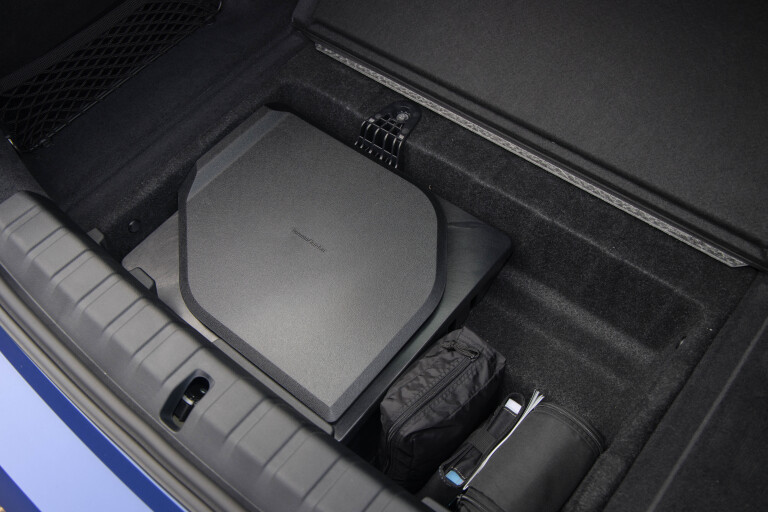
As the car comes with a five-year Chargefox subscription, you can charge for free at that company’s expanding EV charging network at between 50kW and 200kW, the maximum rate on the i4’s setup. BMW says that at 200kW, the battery will charge from 10-80 per cent in 31 minutes, which is pretty good going. It will slow considerably after eighty and will take a further half-hour or so based on my experience.
This brings me to my experience. I drove from my home to the nearest 350kW Chargefox charger in Sydney’s East Village shopping centre, a 20-minute drive. It’s the closest rapid charge, the one fifteen minutes away in the other direction only running at 22kW.
There are three chargers in East Village – I’ve used them before – two offering 350kW and the third offering 50kW. Upon arrival, two red lights in the corner of the car park told me both the 350kW chargers were out of service. One of them had failed to give me more than 50kW before Christmas 2021 (when I was charging a Volvo XC40) and they’ve been broken for almost a month. The third charger was, not unreasonably, occupied by another user who would also have been unhappy with their Ioniq 5 chugging along at such a slow speed.
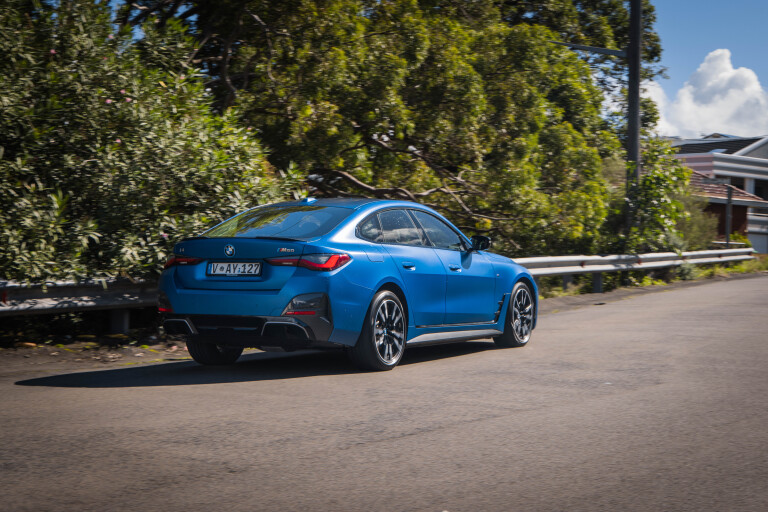
A grumpy Twitter post elicited a response from several other users complaining about Chargefox’s fleet of broken Tritium chargers. That’s not especially helpful and is neither BMW’s fault nor, according to these Twitter users, Chargefox’s fault. Chargefox eventually responded with a tweet about the current challenges and that those chargers are four years old but in the end, they’d been out of action for months and you have to go tappy-tappying in the app to find out that you’ve no chance of getting a charge from them.
There did follow a friendly exchange but the fact remains that Chargefox’s one job is to supply a working charging network and it’s failing, for whatever reason, to deliver that while not being as upfront about it as they could be.
Thankfully, about 200 metres away is a 160kW charger that accepts the Chargefox app. The ABB unit charged the i4 from 59 to 81 per cent in 16 minutes, plenty of time to wander back into East Village for a coffee or whatever. That translated to an indicated increase from 255km to 351km of range. The ABB-branded charger said the car would reach full in another 25 minutes. Once underway, the range increased to 380km, a function of BMW’s pessimistic-but-safe approach to range indication.
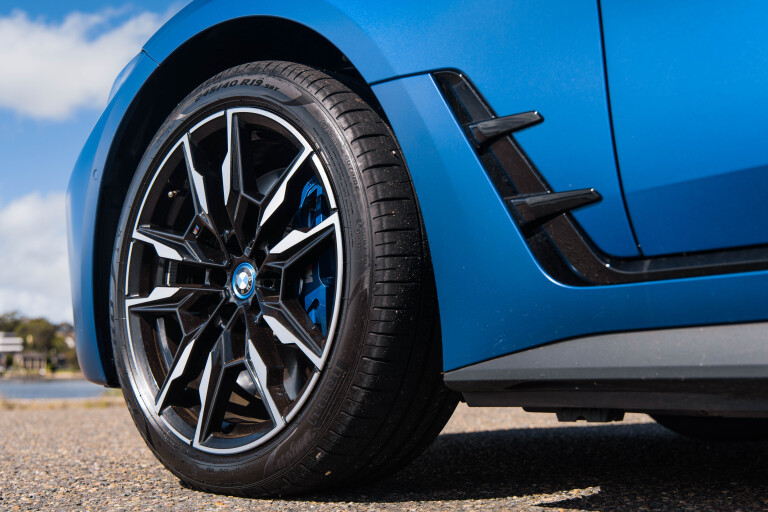
I didn’t go for the coffee, I had too many people asking about the car.
One thing I did notice was that when you punch in a destination on the sat-nav, the car doesn’t route you via charging stations if there isn’t enough juice to get you there. Instead, it suggests that you should charge first and then dynamically updates you as you’re on your way to stop you from running out, the same paradigm as the petrol and diesel BMWs.
On the Road

If you’re just looking for a sleek, nice to drive EV, you’ve come to the right place. If you’re a BMW driver looking for a sporting sedan, the decision is not quite so cut and dried. Partly because BMW is really good at those, but with petrol engines. It’s not cut and dried because the i4 is a proper sporting sedan.
The i4 is, as I’ve mentioned, based on the 4 Series Gran Coupe which itself is based on BMW’s extremely versatile Cluster Architecture known as CLAR. This underpins pretty much every BMW that isn’t front-wheel drive and there are even bits of it in the iX. But this is more identifiably an EV based on an ICE car, which comes with a bit of baggage.
As tired as you might be of hearing this, it means that, like the Polestar and XC40 CMA platform, there are compromises. BMW’s engineers had to find somewhere to put 550kg of batteries, in the M50’s case two electric motor packs, an onboard charger and still make the resulting 2290kg of 4 Series drive like a BMW.
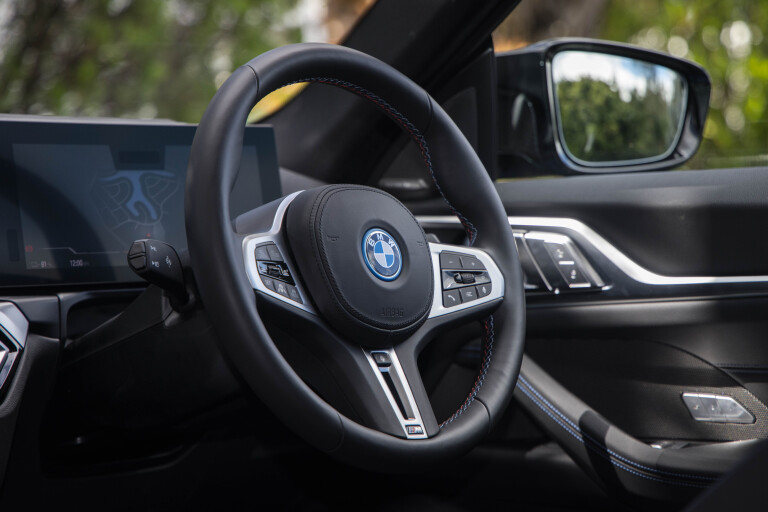
You expect that kind of weight in a larger, higher-riding SUV, you don’t in a 4 Series. Have M’s magicians found a way to mask all that weight? Yes. And no.
Obviously, being an electric vehicle with two motors and 400kW, it’s an absolute rocket in a straight line, clearing the 0-100km/h sprint in 3.9 seconds. The torque is instant, there’s none of the clicking and whirring some EVs have and the traction systems ensure the wheels don’t lose contact. It’s immensely fast and will show an M4 a clean set of LED taillights. That does need Sport Boost mode activated, which gives you access to all the power and 795Nm of torque but even without that, you’re in a mid-four second car. Without waking up the suburb with a poppy-bangy exhaust.
Some of my acceleration runs (for science, obviously) featured a bit of torque steer, with the front end wanting to wander a little from side to side, but not worryingly so. That’s one of the challenges of two separate motors; you can’t shuffle the torque back and forth between axles to reduce that kind of thing. Is it fun? Hell, yes. Does it handle? Yes again.

While you are going to sacrifice the kind of front end that M cars have recently rediscovered, there’s still a pretty nimble car underneath you. The body will roll more than an ICE 4 Series in corners and you’ve got a bit of extra sidewall on the 19s to ensure the ride doesn’t get too jittery as it might on the optional 20s.
M adaptive damping does a great job of controlling the body without destroying the ride quality and even though you’ll feel the bumps, the wheel control is impeccable. It tracks where you want it to go and powers out of corners like a supercar. And if there’s a gap you want, you own it before you hit the accelerator. It’s that fast.
I really like the difference between normal and one-pedal mode, with a simple knock of the shifter to activate or deactivate the latter. As with the iX3, there is an adaptive mode that uses the sat-nav to work out if it’s on a hill or coming up to a bend and adjusts the strength of the energy recuperation accordingly. BMW nailed one-pedal driving first time out on the i3 and the talent has stuck.

Another trick BMW has managed is intuitive braking – some EVs have trouble with the disc brakes’ feel and performance, with some quite grabby and wooden at low speeds. The i4’s transition from regen to friction braking is impressively seamless, which generates a lot of confidence when you’re chucking it about.
But you know it’s nearly 2.3 tonnes and that’s heavy for a five-door coupe.
Despite BMW’s ADR testing coming up with an energy consumption rate of 25.6kWh/100km and despite my fun-loving approach to driving the i4, I was averaging 23.7kWh/100km.
Ownership

BMW lags behind pretty much everyone with its three-year, unlimited-kilometre warranty. One day I hope they change this to at least five years mostly to stop me finding new ways to say I’m disappointed with this short coverage.
The battery is covered by an eight-year warranty capped at 160,000km, which is competitive if not outstanding.
You also get a very generous five-year subscription to unlimited charging on Chargefox’s public charging network. That represents a significant saving, obviously on fuel but time and home charging costs too. If you can find one that works. I am not bitter, just disappointed.

BMW offers two pre-paid service plans. A four-year plan is $1240, working out at $310 per year. If you want to go to six years, you’ll pay $1765, which seems quite reasonable. Cue the shrieking of Tesla adherents about how last century servicing is (it isn’t – cars are rather famous for featuring a lot of moving parts and an array of consumables that need regular attention) and both offers are significantly cheaper than BMW’s ICE and PHEV plans.
VERDICT
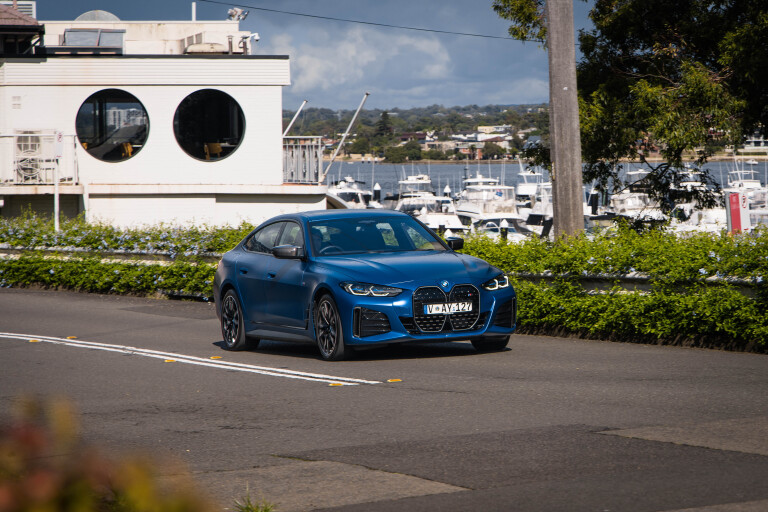
I had a bloke pull up next to me in traffic in his supercharged Range Rover and ask should he buy the i4 M50 or get an M3. Really, I’d have to sit down with him and find out what he really wants from a car. If he wants that M driving experience, the i4 M50 (admittedly, it’s not an i4 M) isn’t quite there but it is terrific fun and very accomplished. So it might be there enough for him.
If he wants sledgehammer performance, a good electric range and plenty of fun if not an absolute track weapon, the i4 is the car he wants today. He probably takes the Rangie on long trips, too, so he won’t have to worry about range anxiety. If he wants to take his BMW to the track, the M3 is what he wants, and we all know that’s a niche consideration.
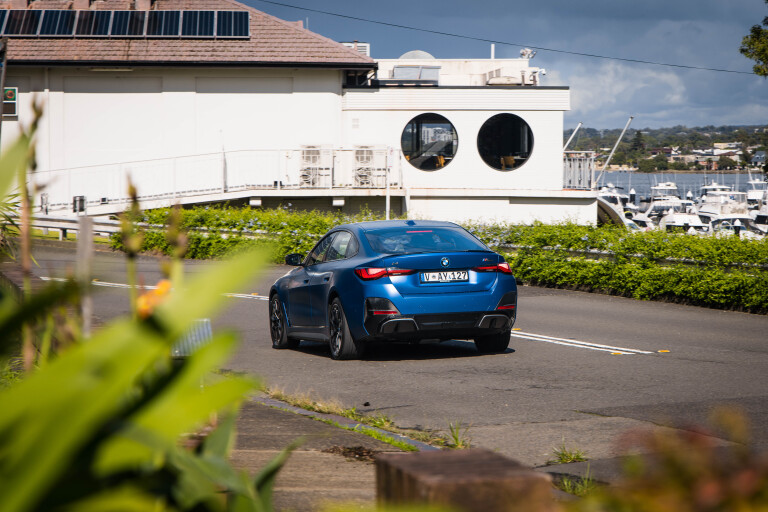
Before I drove it, I wasn’t expecting it to be that close a decision, though, which is a testament to M’s engineering. I am an unabashed fan of the current M3 but like this fellow in the Range Rover, I’d need to think about what I want from the two cars. The M3 is lighter, has better steering, galactically brilliant handling and one of the finest straight-six engines ever put in a car. The i4 M50 is cheaper, faster in a straight line and more comfortable day-to-day.
I gave it back wanting to spend a lot more time in this car to dig into the nuances and find out if I can live with it. Because I think it’s definitely a car most could live with rather than being a pleasantly diverting experience that needs a bit more work.
In other words, it’s not a toy. It’s a proper, liveable electric car and joins an elite group of EVs that can get away with that title.
2022 BMW i4 range specifications
| BMW i4 eDrive 40 | BMW i4 M50 | |
|---|---|---|
| Body: | 5-door, 5-seat coupe | 5-door, 5-seat coupe |
| Drive: | rear-wheel | all-wheel |
| Engine: | single current-excited synchronous motor | dual current excited synchronous motors |
| Transmission: | single speed | single speed |
| Power: | 250kW | 400kW |
| Torque: | 430Nm | 795Nm |
| AC charging | 1.8kW (max 11kW) | 1.8kW (max 11kW) |
| DC Charging | max 200kW | max 200kW |
| 0-100km/h: | 5.7s (claimed) | 3.9s (claimed) |
| Battery | 84kWh/81kWh useable | 84kWh/81kWh useable |
| Energy consumption: | 22.2kWh/100km (ADR) | 25.6kWh/100km (ADR) |
| Weight: | 2125kg | 2290kg |
| Suspension: | MacPherson struts front/multi-link rear, adaptive damping | MacPherson struts front/multi-link rear, adaptive damping |
| L/W/H: | 4783mm/1852mm/1448mm | 4783mm/1852mm/1448mm |
| Wheelbase: | 2856mm | 2856mm |
| Tyres: | 245/40 front, 255/40 rear R19 | 245/40 front / 255/40 rear R19,Pirelli P-Zero |
| Wheels: | 19-inch alloy (no spare) | 19-inch alloy (no spare) |
| Price: | $99,900 + on-road costs | $124,900 + on-road costs |
Score breakdown
Things we like
- Looks great
- Inventive soundscape
- Fantastic driveline
- Handles well given the weight
Not so much
- Feels heavy
- 19-inch wheels somehow look small
- Tight rear seat

COMMENTS